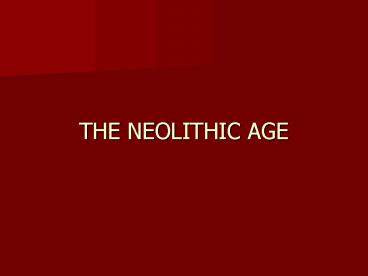THE NEOLITHIC AGE PowerPoint PPT Presentation
1 / 26
Title: THE NEOLITHIC AGE
1
THE NEOLITHIC AGE
2
The Neolithic Revolution-Brief Review
- 1) Hunting and Gathering
- - Human origins to Paleolithic (Old Stone
Age) - 2) Use of Wild Grains
- - Transition to agriculture 11,000-8500 BCE
- - Long period, complex transition
- - Role of climate change end of Ice Age,
dryer climate - 3) Neolithic (Agricultural) Revolution
- - New Stone Age
- - Farming as main food source 8500 BCE (Near
East) - - First domestic animals dog, sheep, goat
- - Wide-ranging social, cultural consequences
3
The Neolithic Revolution
- 1) Food Raising
- - Agriculture, domestic animals
- 2) Settled Life
- - Villages? towns? first cities
- 3) New Technologies
- - Pottery, textiles, baskets
- 4) Social Organization
- - Hierarchy, warfare, state formation
4
The Neolithic Worldwide
- Fertile Crescent (Mesopotamia)
- - 8500 BCE wheat, millet, spelt dog,
sheep, goat - South Asia (Indus River valley)
- - 7000 BCE wheat, millet, spelt dog,
sheep, cattle - East Asia (China Yellow and Yangtze rivers)
- - 6000 BCE millet (Yellow), rice (Yangtze)
dog, pig, sheep, cattle - Central America (Valley of Mexico)
- - 6000 BCE Corn, squash, beans dog, but no
other animals - Many other regions had independent Neolithics
- - Egypt, Ethiopia, Vietnam, Peru, South
American rainforests - - Many diverse first domesticates (esp.
plants) - - Some unique domestic animals llama, zebu
5
(No Transcript)
6
(No Transcript)
7
(No Transcript)
8
(No Transcript)
9
The First Settlements (Villages)
- Rise of settled villages parallels origin of
agriculture - Some places get both, some get one or the other
- Settlement allows new survival strategies food
storage, having more babies (dont need to carry
them) - Settlement also brings problems, esp. disease
(smallpox, measles, malaria, tuberculosis,
influenza)
10
(No Transcript)
11
Çatal Hüyük
- prominent village located in Turkey,
occupied 7250-5400 BCE - 32 Acres enclosed by city walls. Estimated
population of 6,000 people. - - What do you notice about the lay out of
the village?
12
CHANGES IN TECHNOLOGY
13
Improvements in agriculture, trade, and
transportation
- Pottery
- Why is this important?
14
Improvements in agriculture, trade, and
transportation
- Plows
15
Improvements in agriculture, trade, and
transportation
- Woven textiles
- This loom is similar to ones used in Egypt c.
4400 B.C.E.
16
Improvements in agriculture, trade, and
transportation
- Metallurgy
- The Bronze Age doesnt come about until later,
but there is evidence that people were
experimenting with early metals at Catal Huyuk.
17
Improvements in agriculture, trade, and
transportation
- Wheels and wheeled vehicles
- The wheel comes about later in this time period.
- How would it change life?
18
Excavations at Catal Huyuk
19
The Walls of Jericho
20
Excavations at Jericho
21
Statue of Goddess
22
The Great Ziggurat of Ur
23
Demographic Changes
- Food production supports higher populations
- - Families can produce surplus
- - Sedentary lifestyle allows more children
- However, sedentary life increases disease
- - Diseases contracted from animals
- - More people in one spot ? infection
- - Staying in the same place is dirty
- Population growth prevents return to gathering
24
Social Transformation
- Increasing Organization
- - Families
- - Big mansocieties
- - Chiefdoms
- - States
- Social Stratification/Hierarchy
- - Food producers support non-productiveelit
es - - Craft specialization
- - Religious elites (priesthoods)
- - Hereditary rulers (kings)
- - Slavery
- - Gender discrimination
- Warfare Between Large Groups Begins
25
The First States
- From Chiefdom to State
- - Chiefdom ranked society
- - State class society
- - Competition among chiefdoms drives state
formation - - Warfare and trade as basic to emergence of
state - Functions of the State
- - Law suppress internal disorder
- - Defense against external threats
- - Redistribute resources from producers to
consumers (elites) - - Appease the gods to maintain harvests
26
Basic Elements of Civilization
- Political (territory-based) institutions
- Organized religion
- Urban/administrative centers
- Hierarchical system of classes
- Taxation (far from universal)
- Division, specialization of labor
- Further technological development
- Trade (but note Paleolithic luxury trade)
- Writing (a late step!)

